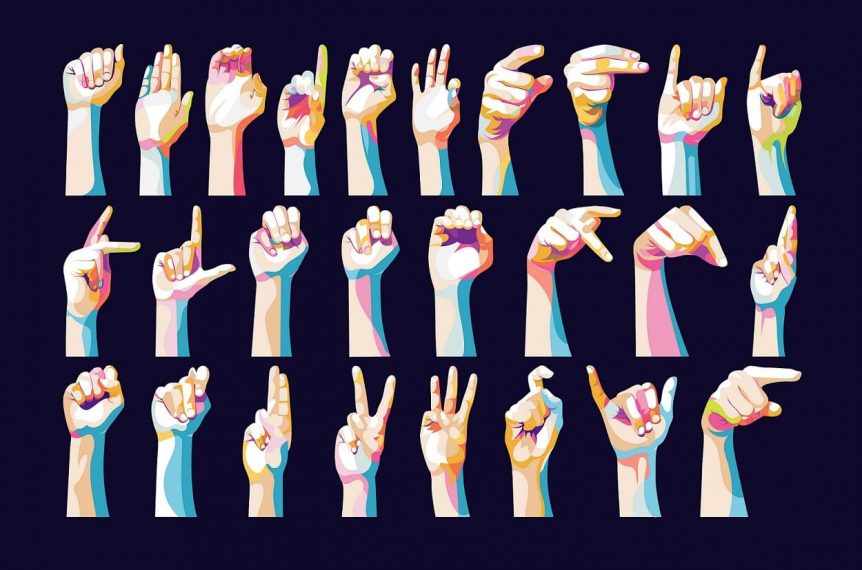Is Sign Language Universal?
There are numerous ways to communicate with people, including gestures, language, music, or facial expressions. Speaking about sign language, it’s more than just a language. It’s the bridge that connects us to the world of those who are deaf or have hearing impairments.
Sign language is also used by hearing individuals, such as those who have deaf family members or who are unable to speak physically.
Although you might not know how to use sign language, you must have either seen it somewhere in public, in movies, in clips, or used by a sign language interpreter at a conference.
If you are wondering if the language is universal, we have the answer for you: no. As with spoken languages, there are many different forms of sign languages that differ across countries.

How Does Sign Language Differ Between Countries?
Generally, today there are approximately 300 different sign languages used worldwide, varying from nation to nation.
Even in countries with the same spoken language, sign language can have multiple regional accents bringing subtle differences in how signs are used and understood.
Not only signs differ. The speaker’s gestures, body language, and facial expressions significantly affect how sign language is conveyed.
For instance, let’s take the British and Americans. They both have English as their native language. However, when comparing American Sign Language and British Sign Language, you’ll see that they are completely different. Moreover, they belong to different language families.
Here is one more interesting fact: American Sign Language has more similarities with French Sign Language than with British one as it has been developed through it. So American Sign Language has certain elements of French Sign Language.
What are the Different Types of Sign Languages?
As has already been mentioned, each country has its own sign language. Just like with spoken languages, different types of sign languages have their grammar, idioms, and everything else related to language.
Apart from the above-mentioned American Sign Language (ASL), British Sign Language (BSL), and French Sign Language (FSL), there are many other types. Let’s discuss some of the most popular ones.
Chinese Sign Language
There are approximately 20 million deaf people in China who use Chinese Sign Language.
The first Chinese school for the deaf was founded by an American missionary, C.R. Mills, and his wife in 1887. The appearance of schools and workshops for the deaf helped spread CSL in the country.
Modern Chinese Sign Language has been developing since the late 1950s, and its signs resemble written Chinese characters.
Irish Sign Language
At least 5000 deaf people speak the Irish Sign Language, commonly used in the Republic of Ireland.
You can find similarities between Irish Sign Language and American Sign Language, as ISL is mainly influenced by ASL.
Gender signs are the most captivating aspect of the Irish Sign Language. Due to separate Catholic schools for boys and girls, there was created a “gender Irish Sign Language.” As a result, sign language for males and females differs.
Spanish Sign Language
Spanish Sign Language is used by nearly 100,00 people almost across entire Spain. The exceptions are Valencia and Catalonia, which have their own signed languages (Valencian Sign Language and Catalan Sign Language).
The language was influenced by French, American, and Mexican sign languages. Spanish Sign Language itself influenced Venezuelan Sign Language.
Mexican Sign Language
Being one of the national languages since 2005, Mexican Sign Language is used by almost 100,000 people in Mexico.
It is related to the French Sign Language family. Compared to SSL, Mexican Sign Language has less vocabulary, and it rarely uses the verb “to be.” Most of the articles and pronouns are also omitted in the MSL.
Is There a Universal Sign Interpreter?
As in the case of universal sign language, there is no universal sign interpreter.
You won’t be able to find one sign interpreter who can understand and communicate with the whole deaf community. No sign interpreter knows all those diverse types of sign languages. Everyone is specialized in their own, depending on the country and region.
The Bottom Line
Considering that there is one universal sign language used worldwide is a surprisingly common opinion. However, that’s not true.
Each country has its own sign language, and some countries even have more than one. Let’s take, for example, the UK. Different regions within the country have their unique dialects and colloquialisms.
Based on this, there are British Sign Language (BSL), Irish Sign Language (ISL), Sign Supported English (SSE), Makaton, and BSL taught through spoken Welsh.
Like spoken languages, sign languages have their syntax, grammar, and vocabulary. Unlike popular belief, sign languages are not dependent only on the use of hand and body gestures.
The nature and history behind sign language are extremely captivating and definitely worth your attention.


